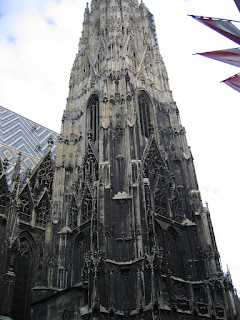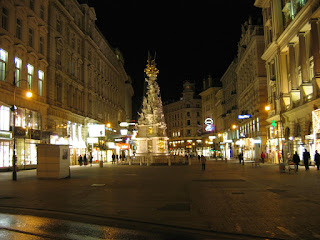
After the choir left for South Korea and my days of touring Prague and attending the tech conference came to an end, I decided to head to Vienna Austria for a week. My time in Vienna looked similar to my time in Prague, in that I spent much of it getting to know the city. Many a day I simply walked the streets entranced with the architecture and history surrounding me. I got a little frustrated, however, with the local people because most of them had their heads down, rushing around, oblivious to the beauty around them. Often I felt like telling them to "look up" and appreciate their neighborhood! I guess we all have a tendency to take our local environment for granted.

It's near impossible to share all the things I learned and experienced during a trip like this, such as the story behind finding the bus station in Prague or arriving in Vienna for the first time or what it was like staying in a hostel with students from International schools around the world or riding the Metro/U-bahn or what I noticed about the people, food, language, etc.


So I'll just hit the highlights of the city's built environment in this blog: that which makes Vienna different from other cities from an architectural point of view. Let's start with Stephansplatz at the epicenter of Vienna...

Stephansplatz is a plaza-like area in the oldest part of Vienna and is named after its most prominent building, the Stephansdom, one of the tallest cathedrals in the world. Here's a picture of the cathedral taken in 1870. And no, I didn't take the picture ... I can hear the wisecracks way over here in Korea.
Although the church was completed in 1160, major reconstruction and expansion lasted until 1511 and repair and restoration projects continue to the present day. In fact, I was told workers continually wash the limestone exterior because it absorbs pollution, turning the stone from a light to near black color every two years. I guess 700-800 years ago they didn't have the pollution we do now so using an absorbent cladding like limestone was not an issue.


During World War II, St. Stephen's Cathedral was saved from intentional destruction at the hands of retreating German forces when a captain disregarded orders from the city commandant to "fire a hundred shells and leave it in just debris and ashes." On April 12th 1945, however, fires from nearby shops -- started by civilian plunderers as Russian troops entered the city -- were carried to the cathedral by wind, severely damaging the roof and causing it to collapse. Fortunately, protective brick shells built around the pulpit, Frederick III's tomb, and other treasures, minimized damage to the most valuable artworks.
The Black Plague memorial is prominently displayed in the center of Stephansplatz in memory of the 76,000 residents who died (mostly from bubonic plague) in 1679-80. I passed the memorial as I made my way through the narrow streets to the Hofburg Imperial Palace. This palace has housed some of the most powerful people in Austrian history, including the Habsburg dynasty who lived here during the winters and at Schonbrunn Palace in the summers. Today the wings of the palace are used for varying purposes, including headquarters of the Vienna Boys Choir, government offices, museums and national library.


The gardens surrounding the Hofburg Palace are beautiful -- even in February! Hundreds of thousands gathered in this space when Hitler gave a speech and marched his army into Vienna after its occupation. Here are a few photos of the area taken during my visit and a great website that shows pictures taken during the 1938 occupation:
http://www.thirdreichruins.com/vienna.htm.




Vienna takes on a whole new charm at night. Here are some shots of the platz and nearby courtyard where I met some friends for dinner (Trisha, a good friend from my Denver-daze and her beau Matt - pictured below). We dined at The Bretzel Gwolb, a restaurant which goes down into a cellar area below the courtyard where Jews hid during the occupation. It's hard to imagine the rounding up of the Jewish people by Nazi soldiers in this very space only 80 years ago.




The city hall (Rathaus) with its outdoor skating is a beautiful sight during winter evenings. Apparently the city has various activities in front of the city hall all year long, including ice skating in the winter.
As for the city hall, it serves as the seats of the mayor and city council as well as Governor and Assembly of the State of Vienna. The Rathaus was designed by Friedrich von Schmidt in the Gothic style and built between 1872 and 1883. It kind of reminds me of the Canadian parliament building in Ottawa Ontario, including the skaters.


 (Feb 6, 2008) "I'm sitting at a guest computer terminal at the Hotel Wien in Vienna Austria and thought I would email you before I head back to South Korea in a few days. It's interesting to access hi-speed internet and communicate with you around the world while sitting in a 150 year old hotel! Pictures of the hotel line the hallways showing decades of history. You know, it's hard to imagine all the history that has happened during this past century. Interesting to think these rooms and walls were standing during World War I, through the occupation of Hitler, times of emperors, founding of the Vienna Symphony, bombing attacks and a World Exhibition in 1873, to name a few events. Needless to say, wherever I go in this city it oozes history!
(Feb 6, 2008) "I'm sitting at a guest computer terminal at the Hotel Wien in Vienna Austria and thought I would email you before I head back to South Korea in a few days. It's interesting to access hi-speed internet and communicate with you around the world while sitting in a 150 year old hotel! Pictures of the hotel line the hallways showing decades of history. You know, it's hard to imagine all the history that has happened during this past century. Interesting to think these rooms and walls were standing during World War I, through the occupation of Hitler, times of emperors, founding of the Vienna Symphony, bombing attacks and a World Exhibition in 1873, to name a few events. Needless to say, wherever I go in this city it oozes history! Well, you're probably wondering why I'm in Europe in the first place. Let me give you a Reader's Digest explanation: I was asked to chaperon select members of our school choir to Prague and then attend a tech conference in the same city... in fact, as it turns out, close to the same neighborhood! Amazing timing how the tech conference started only two days after the choir headed back to Korea. Talk about a change of pace: from trying to keep up with choir kids to talking tech with techno-geeks! All around, it was a wonderful and varied time in the Czech Republic.
Well, you're probably wondering why I'm in Europe in the first place. Let me give you a Reader's Digest explanation: I was asked to chaperon select members of our school choir to Prague and then attend a tech conference in the same city... in fact, as it turns out, close to the same neighborhood! Amazing timing how the tech conference started only two days after the choir headed back to Korea. Talk about a change of pace: from trying to keep up with choir kids to talking tech with techno-geeks! All around, it was a wonderful and varied time in the Czech Republic.









































